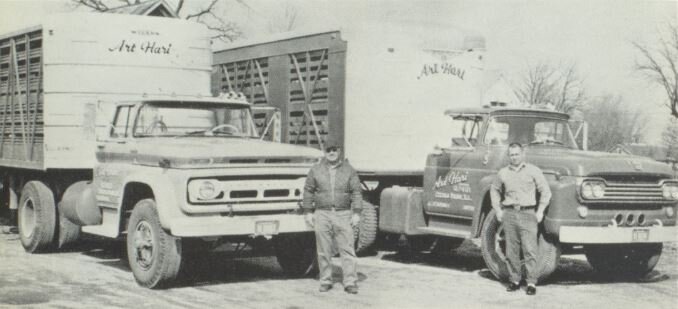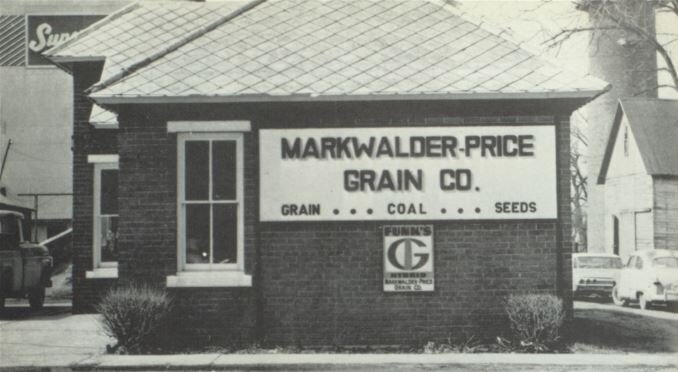
Early History of Cissna Park, IL
Cissna Park History
In 1880, the land in this vicinity was devoted to farming and livestock raising. The land was wet and swampy, much of it being covered with water during the spring months. There were few trees to be seen, only a few scattered here and there. By 1880-81 the need for a town, and a railroad to haul livestock, grain and freight became evident. Mr. Wm. Cissna, along with Messrs. Wm. Clayton, Wm Goodwine and J.B. Wilson went to see about getting a branch railroad to connect with the main C.E. and I road……..Continued Below
Cissna Park Schools
1951 Cissna Park Cheering
1970 Cissna Park Basketball
Art Hari Trucking
Barth & Lober Barber Shop - Best Flat-Tops in Town
Bauer Farm Service
Bauer Clothing
Cissna Park State Bank - 1965
DuAll Furniture
DuAll Furniture
Schippert Softwater Service
Ed Alt Trucking
Feller's Locker Plant
Harolds Shell Service
Markwalder-Price Grain
Muench Texaco
S. J. Hoffmann & Sons Ribstone Silos
Cissna Park Co-op Lumber Co.
Dairy Queen
The Early History of Cissna Park
Early History of Cissna Park 1881-1891 In 1880 the land in this vicinity was devoted to farming and livestock raising. The land was wet and swampy, much of it being covered with water during the spring months. There were few trees to be seen, only a few scattered here and there.
By 1880-81 the need for a town, and a railroad to haul livestock, grain and freight became evident. Mr. Wm. Cissna owned many acres in this vicinity. He was engaged in farming and livestock raising on what is now the Wm. Farney home, just south of town. He resolved to do something about a town and railroad. So he, with Messrs. Wm. Clayton, Wm Goodwine and J.B. Wilson went to see about getting a branch railroad to connect with the main C.E. and I road. They succeeded in getting this branch of eleven miles. Work was begun at once and the completion was celebrated by the driving of a spike by Messrs. Cissna and Clayton near the end of 1881. Mr. Enoch Hinckley was the first agent. The railroad prospered greatly in these early years and was soon carrying loads of livestock, grain, and other freight. The train was nicknamed the "Backup." It went in and out twice a day, going as far as Hoopeston. Two passenger coaches were soon part of the train. The coming and going of the train seemed miraculous and many people watched each time. So fat the name of the proposed town had been simply Cissna, but this was soon changed to Cissna Park, due to the confusion caused by another small town in Illinois having the name of Cisne.
Mr. Cissna donated the land for the park and financed the erection of several buildings. The town was laid out around the park. Early buyers of lots were Messrs. Bundy, Pusey, Turner, Harvey, Ammerman, Young, Hamilton and others. A hitchhiking rack was built around the park, so that people could tie their teams and saddle horses. Wagons were widely used, but buggies were very few in number. Work was begun on buildings and houses and completed as rapidly as possible.
Among the first buildings was the "Park House" hotel built by Mr. Cissna in 1881-1882. This stood where the Rose building now stands. This hotel kept boarders and roomers, had a dining room capacity of 30-40 people and sleeping quarters for approximately half that number. The cooking was done on two large wood burning stoves. Guests included train men, traveling men, tile factory employees and visitors. The first dentist, Dr. Crigler of Saybrook, came to the hotel tow days month. Mr. Cissna kept tow rooms for himself, and soon moved into them giving up farming to attend to his business affairs.
Now we will mention a few of the buildings erected in 1881-82. The first store was built in 1881 by Messrs. Young and Hamilton. This is the store now operated by Martin Bros. It was a general store, carrying groceries, men's clothing and yard goods. The first bank was located in the rear part of this building. It was separated from the store by a low iron railing.
The second store was also a general store built by Messrs. Harvey and Truner in 1882.
The first restaurant was erected in 1882. This is where the Clinic now stands. It was first operated by Mr. and Mrs. Elgas, who had living quarters upstairs.
Next to the restaurant was the first meat market. One of the first proprietors was Joe Burt.
The first drugstore was built where the bank now stands. It served as the offices of the Drs. Bundy, and the post office, as well as the drug store. Miss Lizzie Rose was the first postmistress.
Mr. Cissna erected the present Crum building. It was rented to Mrs. Carter who used it as a military store. Her assistant was Miss May Densmore.
In 1882 another general store was built and operated by Messrs. White and Lindley. This where the Dri-Gas store now stands.
Many lots had been sold and homes went up as rapidly as possible. Lots were sold for about $50 apiece. Houses were built at quite some distance apart.
Early homes built included: the Schley home, the first house on the west side of the park, now the Fred Enz: two Helmer houses built where Marathon oil station and Mrs. Roll's home stand; the Morris home where Dr. Danforth lives; the Dement home built where Mrs. W.W. Dryden now lives; the Heath home where Henry Reiches lives; the three Drs. Bundy built in the east part of town, home which are now the homes of Glen Feller, Charles Schaefer, and George Cruse.
Cissna Park had several doctors. First came the three Drs. Bundy. They came in 1881-82 from Ash Grove (Pitchin). They were established in the drug store on the bank corner. Then in succession came Drs. Hockett, Miller, McClintock, Williams and W.R. Roberts. The last named in 1900.
Work was early begun on the present pavilion. It was financed by donations from merchants and from the proceeds of various entertainments given from time to time. Mr. Helmer, who lived in the Zion locality, donated the first trees for the park. These were evergreens and planted by Mr. Helmer and Miss May Densmore in 1884.
By this time the need for tile was keenly felt. Much of the land was swampy or even covered with water. In 1884 Messrs. Songer and Rhodes built a large tile factory just west of the pond back of the present farmers elevator. The pond was the original pit. The tile factory probably did more to add to the value of Cissna Park than any other one thing. It employed 15-30 men the year round. Tiles were supplied to farmers here and elsewhere. So many tile were shipped out that the railroad extended the track 800 feet to the west in order to load them.
Livery stables were an important part of early Cissna Park. One of the first was located across the street from Cluver's Sales and Service and was operated by Charley Brock. Conveyances with of without drivers were furnished, also horses to be ridden horseback. About 6-8 horses, 2-3 buggies were kept here. Another stable was operated by Messrs. Higgens and Ruley located where the Legion Home now stands.
Increased production of grain called for an elevator. The first, operated by Joseph Pusey, was built where the Markwalder elevator now stands. The importance of the railroad was further increased by heavy shipments of grain.
The first church was a United Brethren Church. It was established with the beginning of the town and is now the present Methodist Church.
Next came the Union Church with was moved in to its present location, having formerly stood on the Wm. Yergler land 2 miles northwest of town.
The first school was a two story, four room frame structure, set at the northeast corner of the present Consolidated Grade School. Only 2 rooms, each having 1 teacher, were used at first. Two of the earliest teachers were C.C. Wilson and Miss Birdie Willis.
On March 25, 1891, the first newspaper, "The Cissna Park Review" was published. The editor was Frank Frailey. It consisted of 1 double page, cost $1.00 per year, was published weekly.
In the ten years from 1881-1891 enough people had located in Cissna Park to make incorporation possible. The village of Cissna Park was incorporated in 1891. The first president of the village board was George Songer. (From History of Iroquois County page 147, transcribed by Carrol Mick)






















